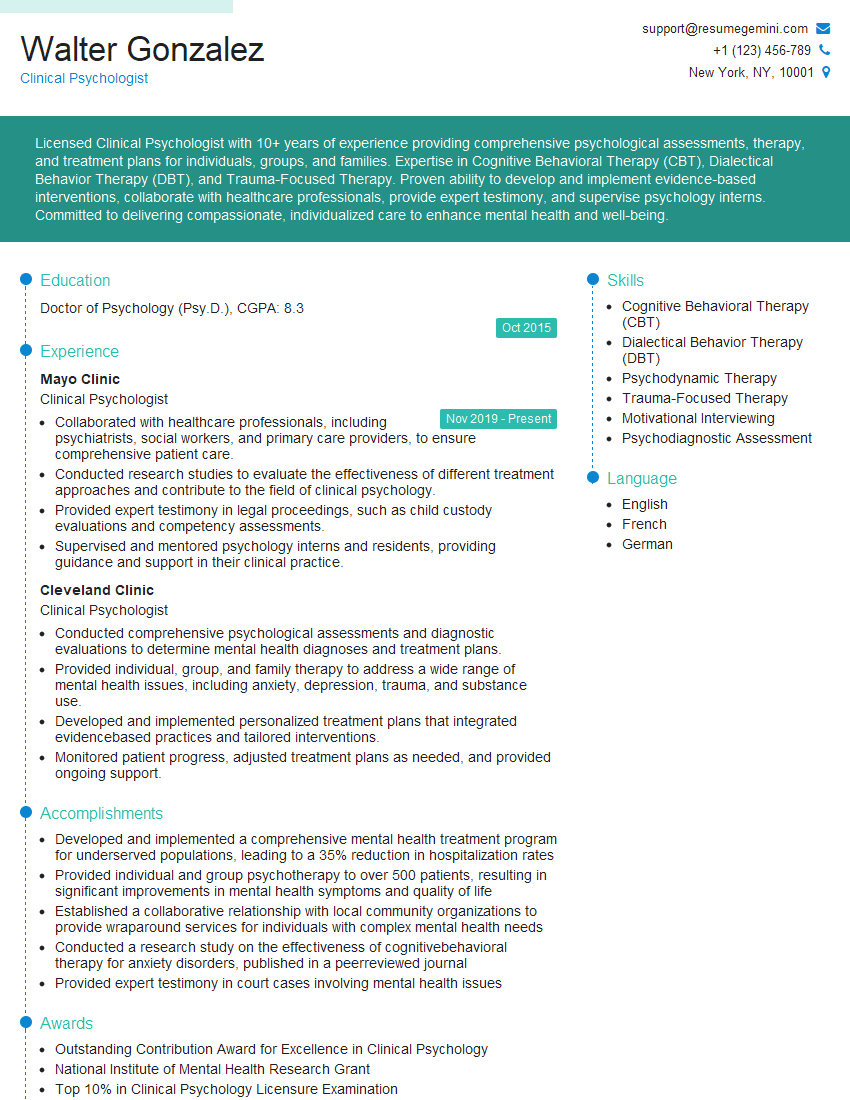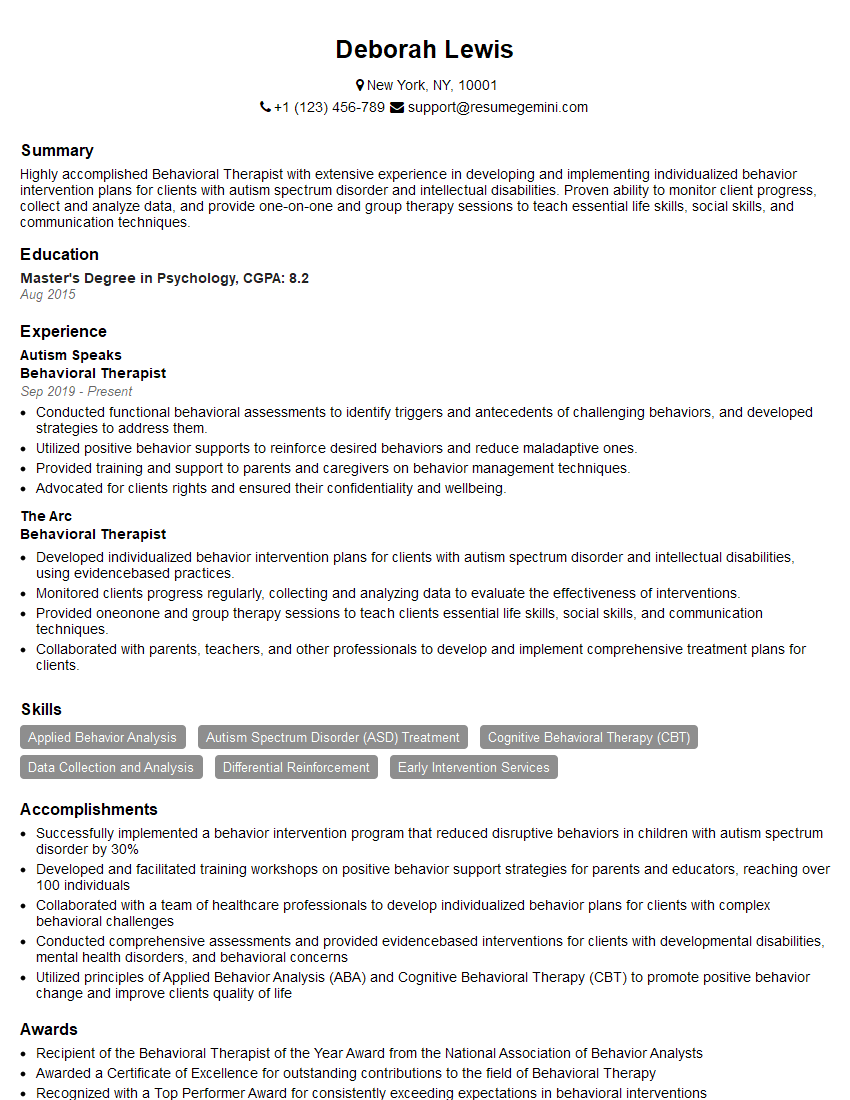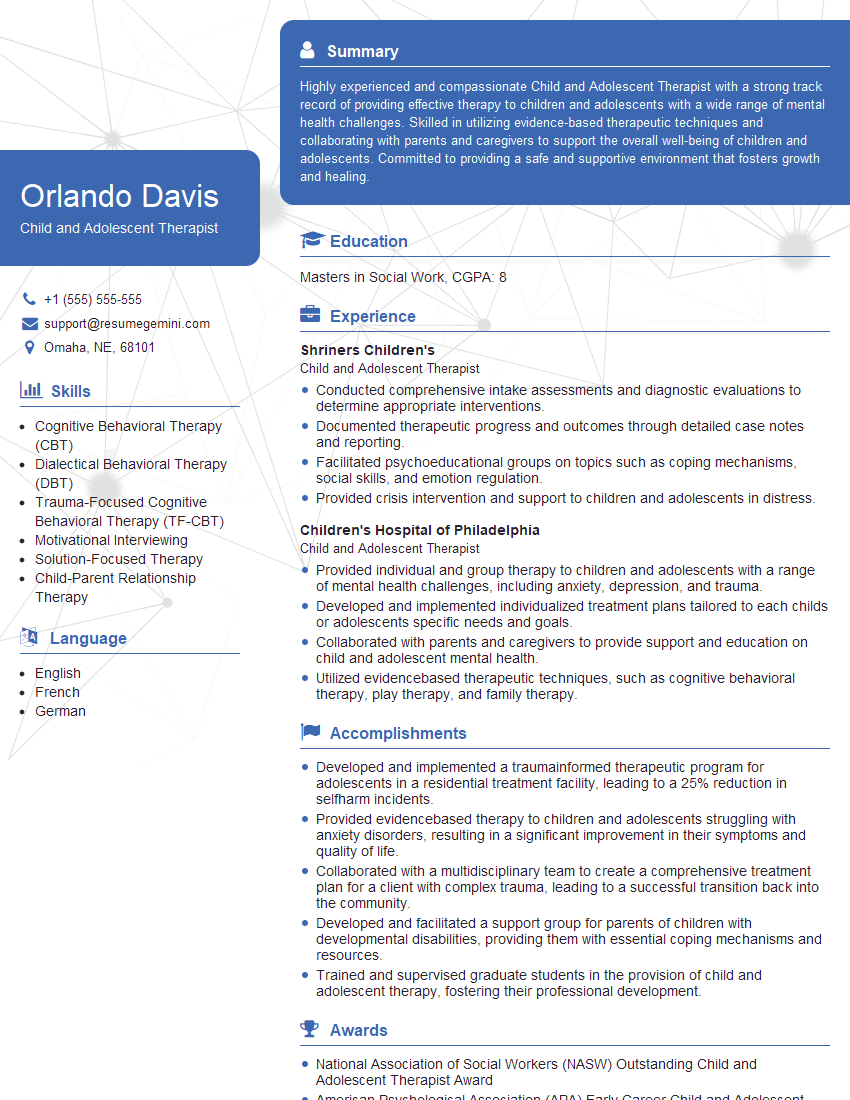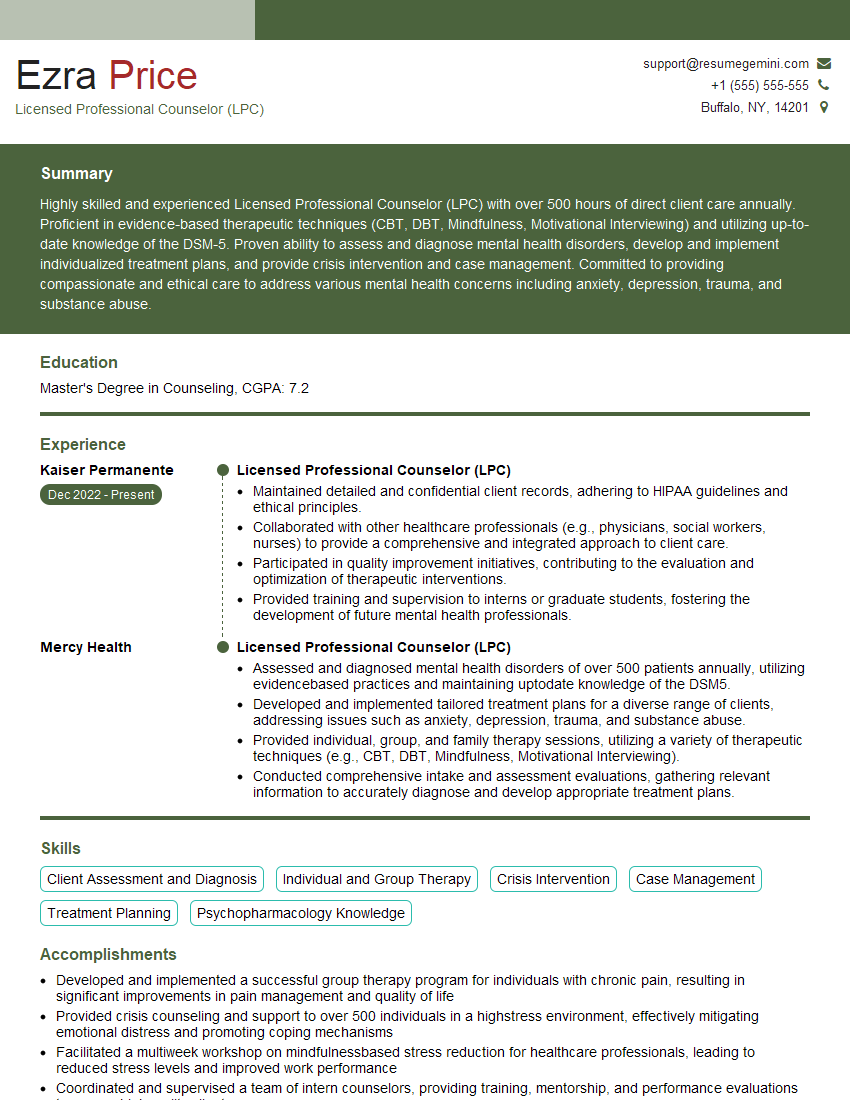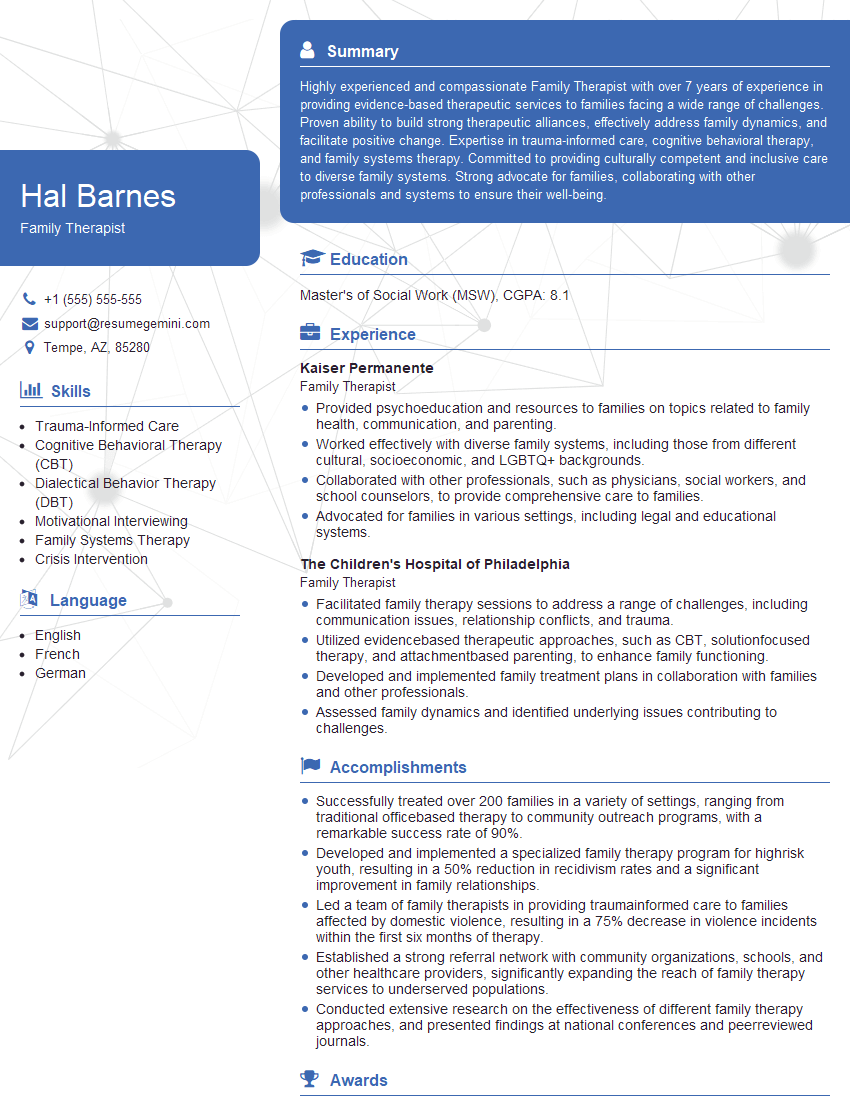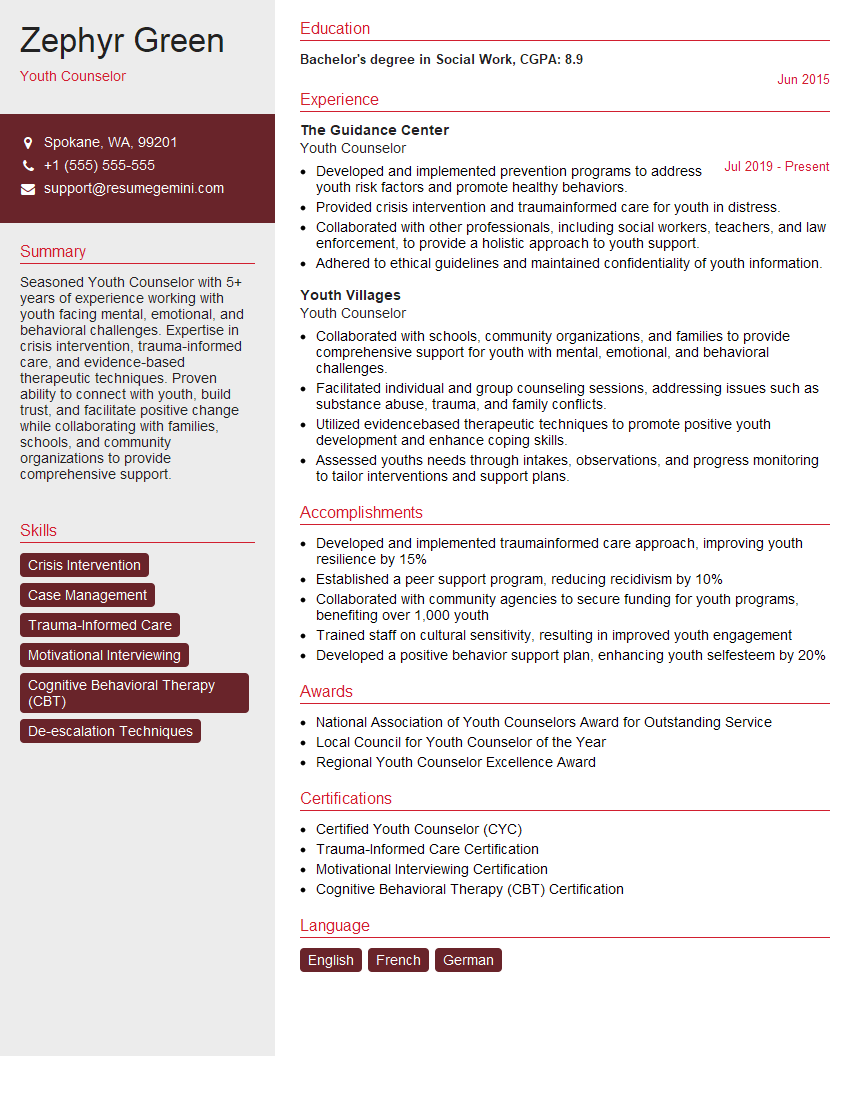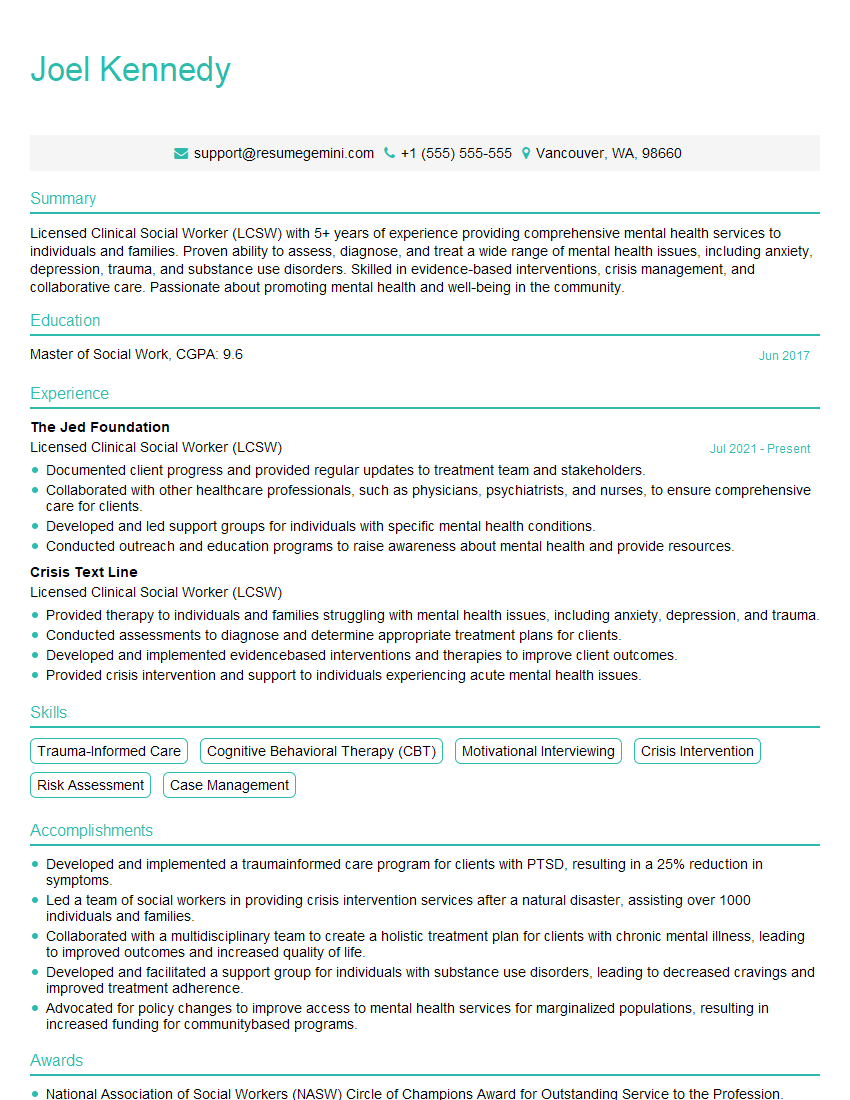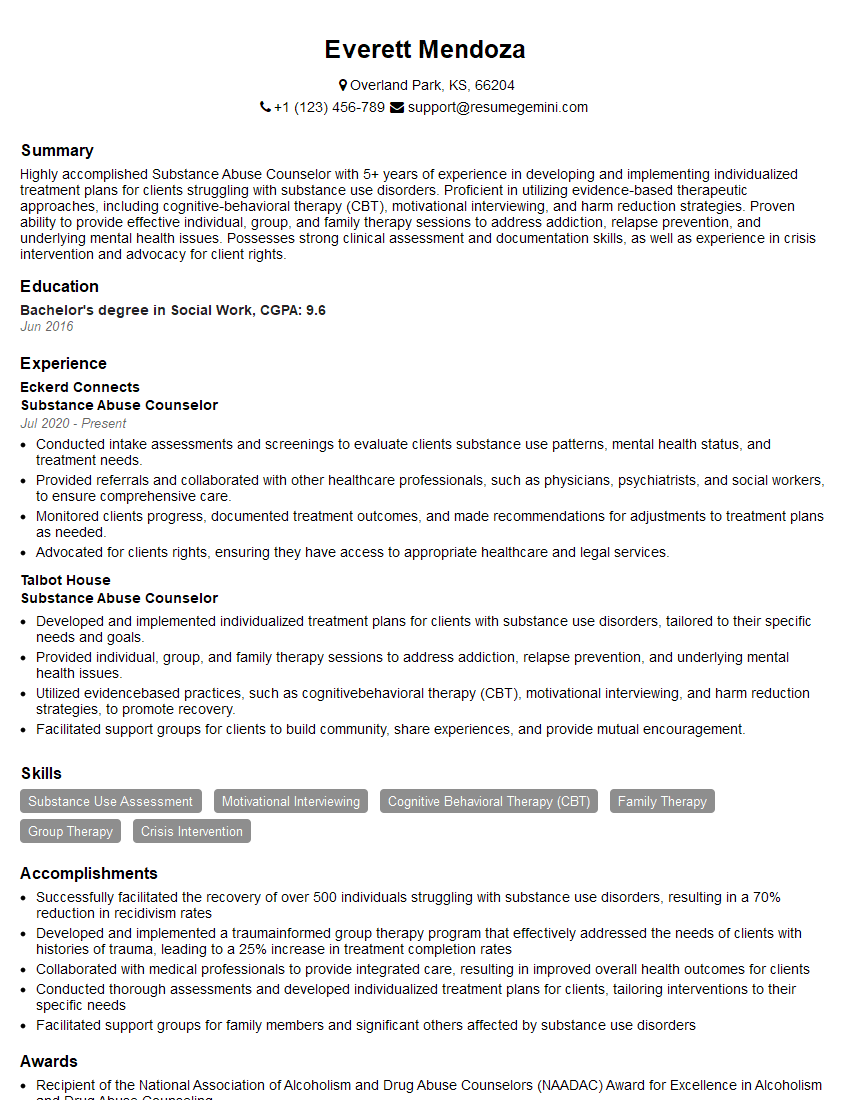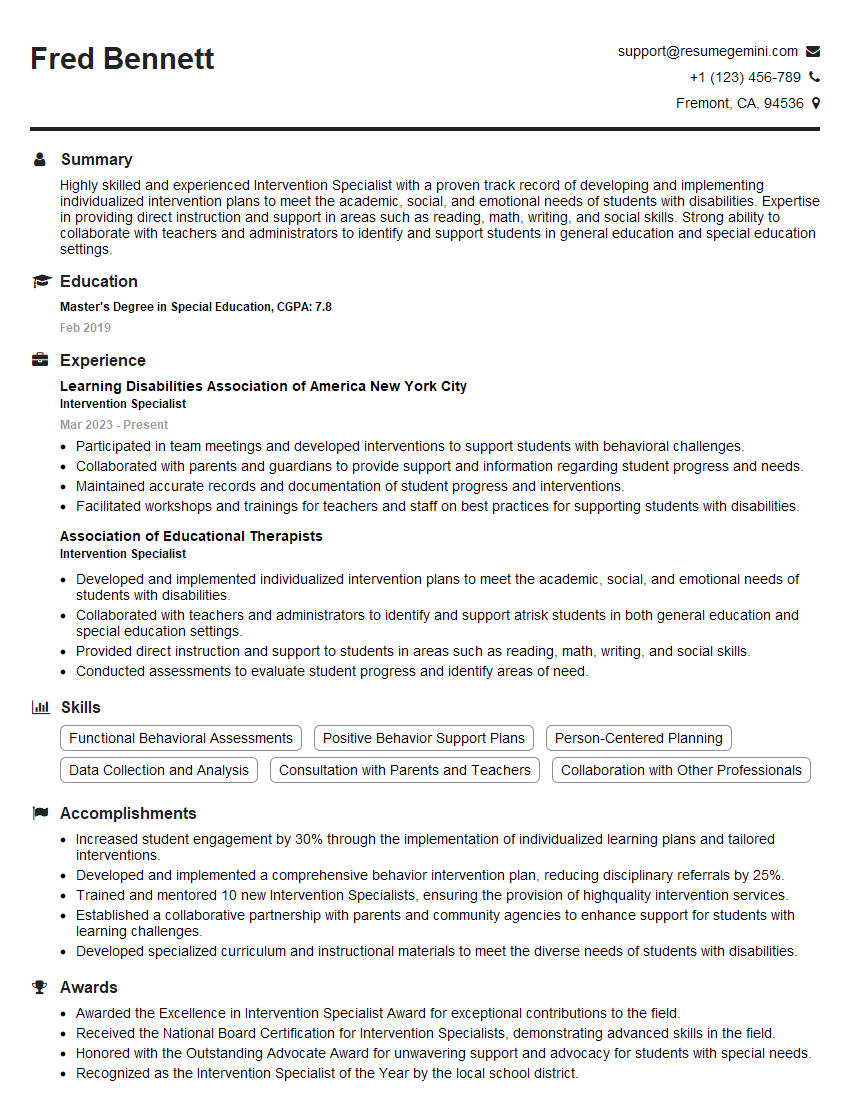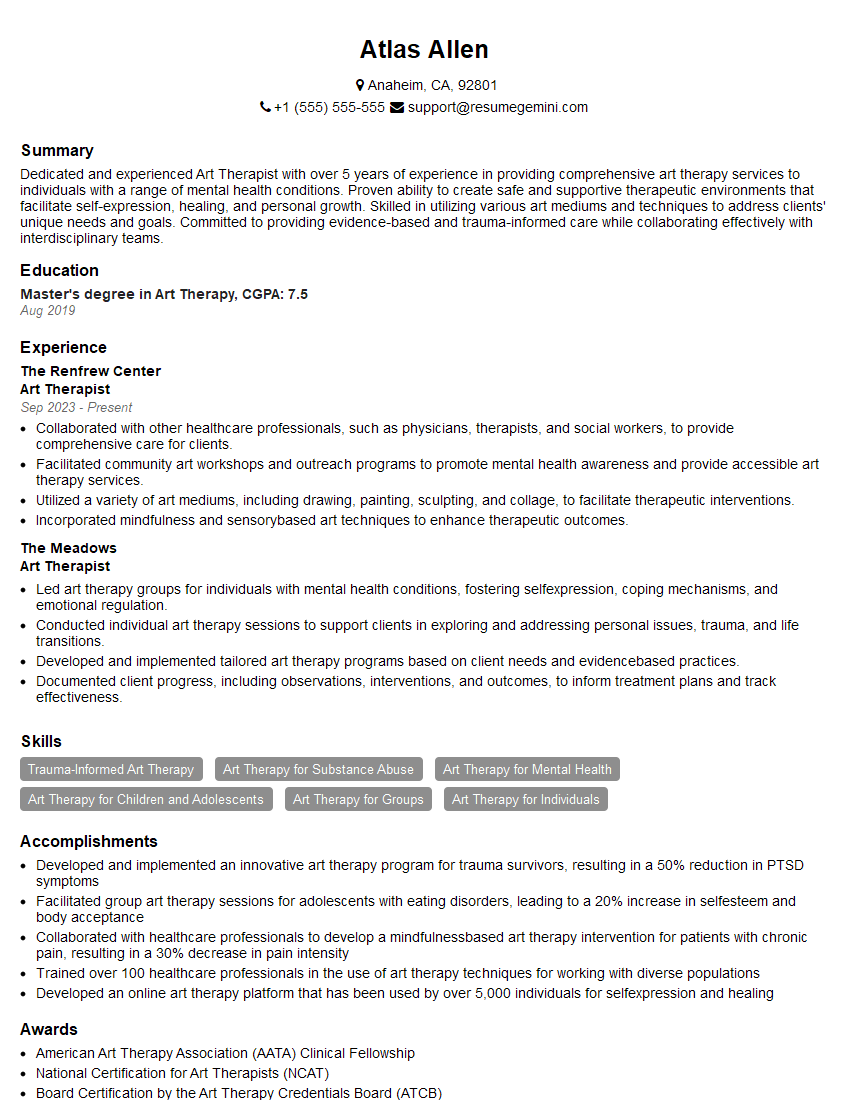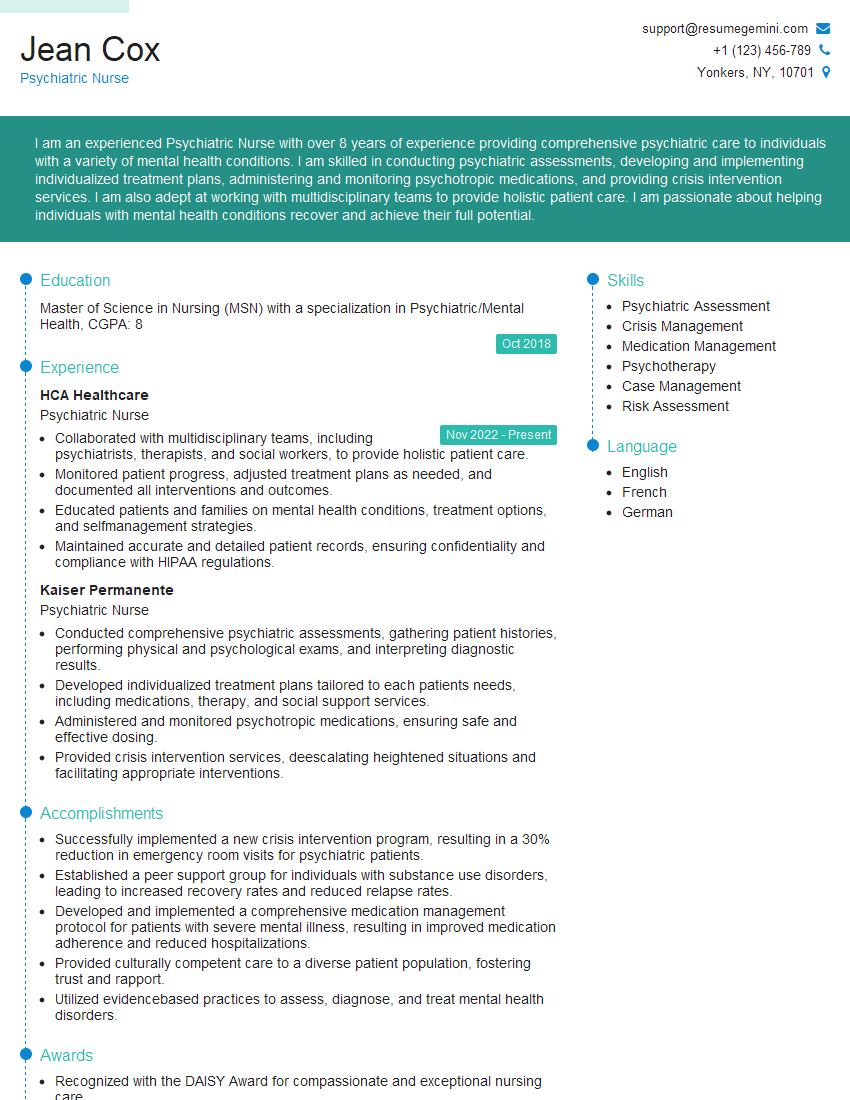Unlock your full potential by mastering the most common Individual and Group Intervention interview questions. This blog offers a deep dive into the critical topics, ensuring you’re not only prepared to answer but to excel. With these insights, you’ll approach your interview with clarity and confidence.
Questions Asked in Individual and Group Intervention Interview
Q 1. Describe your experience in conducting individual therapy sessions.
My approach to individual therapy is deeply rooted in a collaborative and person-centered framework. I believe in creating a safe and non-judgmental space where clients feel empowered to explore their thoughts, feelings, and behaviors without fear of criticism. Each session is tailored to the individual’s unique needs and goals, drawing upon evidence-based therapeutic techniques such as Cognitive Behavioral Therapy (CBT), Dialectical Behavior Therapy (DBT), and psychodynamic approaches, as appropriate.
For instance, with a client struggling with anxiety, I might utilize CBT techniques like cognitive restructuring to challenge negative thought patterns and behavioral activation to encourage engagement in activities that bring pleasure and a sense of accomplishment. With a client grappling with past trauma, a psychodynamic approach focusing on exploring unconscious patterns and relational dynamics might be more suitable. The key is flexibility and a willingness to adapt my methods based on the client’s progress and response.
I prioritize building a strong therapeutic alliance built on trust and mutual respect. This involves active listening, empathy, and a genuine interest in understanding the client’s lived experience. Regularly checking in with the client to ensure they feel heard and understood is essential. Ultimately, the goal is to equip the client with the tools and strategies they need to navigate challenges and lead fulfilling lives.
Q 2. Explain your approach to group therapy facilitation.
Facilitating group therapy requires a unique set of skills, focusing on both individual and group dynamics. My approach emphasizes creating a safe and supportive environment where members feel comfortable sharing their experiences and supporting one another. I utilize a combination of structured and unstructured activities, adapting the group’s focus based on the members’ needs and the overall group dynamic.
For example, I might use psychoeducational techniques to teach coping skills, role-playing to practice interpersonal communication, or creative methods like art therapy to facilitate emotional expression. I actively manage the group’s interaction, intervening when necessary to address conflict, redirect tangents, or ensure everyone feels heard. I also prioritize setting clear group guidelines and fostering a sense of cohesion and mutual respect among members.
A crucial aspect of my facilitation is maintaining confidentiality and ensuring ethical boundaries are maintained. I also regularly assess the group’s progress and adjust my facilitation strategies as needed, ensuring that the therapeutic environment remains conducive to healing and growth. I aim to create a space where members not only receive support but also learn from each other’s experiences and develop their social skills.
Q 3. How do you adapt intervention strategies based on client needs?
Adapting intervention strategies is paramount to effective therapy. It’s crucial to understand that a ‘one-size-fits-all’ approach rarely works. I employ a thorough assessment process, involving interviews, questionnaires, and potentially psychological testing, to gain a comprehensive understanding of the client’s presenting issues, strengths, and personal history.
For instance, a client experiencing depression might benefit from CBT techniques to address negative thinking patterns, while a client with borderline personality disorder may require DBT skills training to manage intense emotions and improve interpersonal relationships. The client’s cultural background, religious beliefs, and personal preferences are also considered when selecting appropriate interventions. I often collaborate with clients to develop personalized treatment plans, ensuring they are actively involved in shaping their therapeutic journey. Regular monitoring and evaluation of the treatment’s effectiveness are also important, allowing me to make necessary adjustments as the client progresses.
Furthermore, I am always open to integrating new information and strategies to tailor interventions effectively. This might involve consulting with other professionals, researching new treatment modalities, or simply adapting my existing approaches based on client feedback and clinical experience.
Q 4. What are the ethical considerations in Individual and Group Intervention?
Ethical considerations are central to my practice in both individual and group interventions. Several key ethical principles guide my work, including:
- Confidentiality: Protecting client information is paramount. I clearly explain the limits of confidentiality at the outset and ensure clients understand the circumstances under which information might need to be disclosed (e.g., child abuse, imminent harm to self or others).
- Informed Consent: Clients must fully understand the nature of therapy, including its goals, methods, and potential risks and benefits, before agreeing to participate. This includes explaining their rights and responsibilities.
- Boundaries: Maintaining professional boundaries is essential to prevent exploitation and ensure the therapeutic relationship remains appropriate. This includes avoiding dual relationships (e.g., becoming friends with a client) and carefully managing any potential conflicts of interest.
- Competence: I only provide services within my scope of expertise. If a client’s needs go beyond my competence, I refer them to a more appropriate professional.
- Cultural Sensitivity: It’s vital to be aware of and sensitive to the cultural background and beliefs of my clients, avoiding any biases that might influence my assessment or treatment decisions.
In group settings, additional ethical considerations arise related to maintaining confidentiality within the group, managing conflicts between members, and ensuring fairness and equality among participants.
Q 5. How do you handle conflict within a group therapy setting?
Conflict is inevitable in group therapy, and it can be a valuable opportunity for learning and growth if managed effectively. My approach involves:
- Early Intervention: Addressing conflicts as they arise, rather than letting them escalate, is key. I intervene when necessary, not to suppress conflict, but to facilitate healthy expression and resolution.
- Active Listening and Mediation: I encourage participants to listen to each other’s perspectives and facilitate a dialogue that focuses on understanding, rather than blame. I might reframe statements, help identify common ground, and suggest alternative solutions.
- Setting Boundaries: Group guidelines, established at the outset, are crucial. These guidelines should define acceptable behaviors and discourage personal attacks or disrespectful interactions.
- Focusing on Shared Goals: Reminding the group of its shared goals and how conflict might impede progress helps to refocus the discussion constructively.
- Individual Support: If a member is repeatedly involved in conflict or struggling to manage their emotions, I might offer individual support or suggest outside resources.
Ultimately, my goal is to help group members learn healthy conflict resolution skills and foster a more cohesive and supportive group environment.
Q 6. Describe a time you had to manage a crisis situation with a client.
I once worked with a client, ‘Sarah,’ who experienced a severe panic attack during a session. She was hyperventilating, trembling, and feeling overwhelmingly anxious. My immediate priority was to ensure her safety and well-being.
I followed a structured crisis intervention approach:
- Safety and Stabilization: I remained calm and reassured Sarah that she was safe and that we would work through this together. I helped her find a comfortable position and encouraged slow, deep breathing exercises.
- Assessment: Once she was slightly calmer, I gently explored the triggers for the panic attack, focusing on what she was thinking and feeling in the moment.
- Intervention: We utilized grounding techniques to help her focus on the present moment, such as focusing on her senses and describing her surroundings in detail.
- Planning: I worked with Sarah to develop a safety plan, including specific coping strategies she could use for future panic attacks. This plan included identifying her warning signs, practicing relaxation techniques, and having a list of trusted contacts she could reach out to.
- Follow-up: We scheduled a follow-up session to debrief the experience and continue working on her anxiety management skills.
This experience emphasized the importance of having a solid crisis intervention plan and the need for flexibility and responsiveness in addressing client emergencies.
Q 7. How do you assess the effectiveness of your interventions?
Assessing the effectiveness of my interventions involves a multi-faceted approach, incorporating both quantitative and qualitative measures.
Quantitative Measures: This might involve using standardized questionnaires or rating scales to track changes in symptoms over time. For example, a depression inventory could be administered at the beginning and throughout the course of treatment to monitor improvements in mood and reduction in depressive symptoms. Similarly, measuring progress in achieving specific, measurable, achievable, relevant, and time-bound (SMART) goals that the client and I have co-created provides objective evidence of treatment success.
Qualitative Measures: In addition to quantitative data, I gather qualitative information through ongoing clinical assessments, regular feedback sessions with the client, and observations of the client’s behavior and progress. Client self-reports and observations of improved coping mechanisms, changes in interpersonal relationships, or increases in overall well-being provide rich qualitative data.
Combining quantitative and qualitative data paints a holistic picture of the client’s progress. If the interventions are not showing the desired results, this assessment process allows for adjustments in strategy, potentially considering alternative treatment approaches or seeking consultation from other professionals. The goal is to continually adapt and refine my interventions to ensure the most effective possible outcomes for each client.
Q 8. What are some common challenges you face in individual and group interventions?
Individual and group interventions, while incredibly rewarding, present unique challenges. In individual settings, building and maintaining a strong therapeutic alliance can be difficult, especially with clients who have deep-seated trust issues or are resistant to change. Time constraints, limited resources, and managing the emotional intensity of individual sessions are also significant hurdles. Group interventions present a different set of obstacles. Managing group dynamics, addressing conflict constructively, ensuring equal participation from all members, and dealing with the varying levels of client engagement and commitment can be complex. Confidentiality becomes a more nuanced issue in group settings as well. For instance, a client might disclose something that triggers a strong emotional response in another group member, requiring careful navigation to maintain everyone’s confidentiality and sense of safety.
- Example: In an individual session with a client struggling with substance abuse, I encountered significant resistance to change initially. It took several sessions of building rapport and exploring their underlying fears before we could collaboratively develop a treatment plan.
- Example: In a group therapy session for anxiety, a client’s unexpected disclosure of past trauma triggered a fellow participant, requiring immediate intervention to de-escalate the situation and reassure both clients of their safety and confidentiality.
Q 9. How do you maintain client confidentiality in individual and group settings?
Client confidentiality is paramount in both individual and group settings. In individual therapy, I adhere strictly to ethical guidelines and legal mandates by securing client information, explaining confidentiality limits (such as mandated reporting of child abuse or imminent harm), and obtaining informed consent. In group settings, the initial session is crucial for setting clear expectations about confidentiality. While complete anonymity is not possible, I emphasize the importance of respecting others’ disclosures and refraining from discussing group content outside the session. I regularly remind participants of the ethical and legal responsibilities involved. I also adapt my therapeutic approach to address potential confidentiality breaches proactively, such as making it clear to the group that individuals should not share what is discussed with others. The session’s safety and the clients’ comfort are always primary.
Q 10. Explain your understanding of different therapeutic modalities.
My understanding of therapeutic modalities is broad, encompassing various approaches tailored to individual client needs. I’m proficient in Cognitive Behavioral Therapy (CBT), focusing on identifying and modifying negative thought patterns and behaviors. I also utilize person-centered therapy, emphasizing empathy, unconditional positive regard, and creating a safe space for self-discovery. Solution-focused brief therapy is another valuable tool, concentrating on identifying solutions rather than dwelling on problems. I find systemic approaches particularly helpful in working with families or couples, exploring the interconnectedness of relationships. My approach isn’t rigidly bound to one modality; instead, I integrate techniques from different schools of thought to create a customized treatment plan. This eclectic approach allows flexibility and responsiveness to the unique challenges presented by each client.
- Example: For a client experiencing panic attacks, I primarily utilize CBT techniques to challenge their catastrophic thinking patterns and teach coping mechanisms.
- Example: With a client exploring grief and loss, I employ a person-centered approach, creating a supportive and non-judgmental environment for them to process their emotions.
Q 11. Describe your experience working with diverse populations.
I have extensive experience working with diverse populations, including individuals from various cultural backgrounds, socioeconomic statuses, sexual orientations, and gender identities. Cultural competence is central to my practice; I understand that different cultural norms and values influence how individuals perceive mental health and engage in therapy. I actively seek to understand each client’s unique cultural background and adapt my approach accordingly. I recognize and challenge my own biases to ensure culturally sensitive and ethical practice. This involves actively learning about the cultural background of my clients and consulting resources to better understand the nuances of how that client’s background might inform their lived experience.
- Example: While working with a client from a collectivist culture, I adjusted my therapeutic approach to incorporate family involvement as appropriate.
- Example: When working with LGBTQ+ individuals, I created a safe and affirming environment where they feel comfortable discussing their experiences without fear of judgment.
Q 12. How do you build rapport with clients?
Building rapport is fundamental to successful therapy. It’s a process built on trust, empathy, and genuine respect. I begin by actively listening to the client, showing genuine interest in their experiences, and validating their feelings. I use open-ended questions to encourage them to share their thoughts and feelings, creating a comfortable and non-judgmental atmosphere. I actively pay attention to their nonverbal communication, mirroring their body language subtly to show that I am fully present. Humor, when appropriate, can also be a valuable tool for building rapport, helping create a relaxed and less intimidating space for self-disclosure. The relationship that forms between the client and the therapist is a key factor in achieving positive treatment outcomes.
Q 13. How do you address resistance from clients?
Client resistance is common and often reflects underlying anxieties or fears. I address it by first validating the client’s feelings and exploring the reasons for their resistance. Open communication and collaborative goal-setting are essential. I explore the client’s perceptions of therapy and address any misconceptions or concerns they may have. By acknowledging their perspectives and reframing resistance as a sign of engagement, I can foster a collaborative therapeutic relationship. I might also adjust my approach, perhaps focusing more on the client’s identified strengths or exploring alternative therapeutic strategies. The key is patience, understanding, and a commitment to working with the client to overcome resistance together.
Q 14. What are your strategies for dealing with challenging client behaviors?
Challenging client behaviors require careful assessment and tailored interventions. The approach depends heavily on the specific behavior and its underlying causes. Safety is always the primary concern; therefore, if there is an immediate risk of harm to the client or others, appropriate measures must be taken, which might include crisis intervention, hospitalization, or involving other professionals. For less severe behaviors, I might use techniques like setting clear boundaries, exploring the function of the behavior, and collaborating with the client to develop alternative coping strategies. In group therapy, addressing challenging behaviors requires careful consideration of group dynamics and maintaining a safe and therapeutic environment. Involving the group in problem-solving can foster a sense of shared responsibility and help address behaviors collaboratively.
- Example: If a client is consistently interrupting others, I would gently redirect them and discuss the impact their behavior has on the group.
- Example: If a client is exhibiting self-harming behaviors, I would work with them to develop safety plans and identify alternative coping mechanisms and potentially collaborate with other professionals.
Q 15. How do you ensure the safety of clients in group therapy?
Client safety is paramount in group therapy. It’s a proactive process, not a reactive one. We start by establishing clear group rules and norms from the very first session, emphasizing respect, confidentiality (within legal limits), and boundaries. This includes explicitly stating that physical violence or threats will not be tolerated and outlining the consequences.
Before the group begins, I conduct thorough individual assessments to identify potential risks, including any history of violence, impulsivity, or substance abuse. I carefully screen participants to ensure the group composition minimizes the likelihood of conflict. For example, I would avoid placing individuals with a history of intense conflict with each other in the same group. During sessions, I actively monitor group dynamics, intervening immediately if any signs of distress, escalation, or unsafe behavior emerge. This might involve redirecting conversations, de-escalating conflicts through active listening and validation, or even temporarily removing a member from the group if necessary. Finally, I ensure that all members have access to emergency resources, including my contact information and crisis hotlines.
For instance, in a group dealing with trauma, I might notice one member triggering another. My intervention would involve acknowledging the emotional reaction, validating the experience, and then guiding the group in a healthy way to explore the underlying feelings without further harming the triggered member. I also maintain clear communication with all participants about the boundaries of confidentiality, particularly regarding any mandatory reporting obligations.
Career Expert Tips:
- Ace those interviews! Prepare effectively by reviewing the Top 50 Most Common Interview Questions on ResumeGemini.
- Navigate your job search with confidence! Explore a wide range of Career Tips on ResumeGemini. Learn about common challenges and recommendations to overcome them.
- Craft the perfect resume! Master the Art of Resume Writing with ResumeGemini’s guide. Showcase your unique qualifications and achievements effectively.
- Don’t miss out on holiday savings! Build your dream resume with ResumeGemini’s ATS optimized templates.
Q 16. How do you create a supportive and therapeutic group environment?
Creating a supportive and therapeutic group environment requires a multi-faceted approach. It begins with establishing a safe and confidential space where members feel comfortable sharing their vulnerabilities. This involves fostering trust and mutual respect among participants. I achieve this by modeling empathy, active listening, and providing constructive feedback. I actively work to create a sense of community and belonging, where members feel seen, heard, and understood.
Structuring the group is also crucial. We establish clear ground rules, focusing on confidentiality, respectful communication, and active participation. I frequently use therapeutic techniques like role-playing, group discussions, and feedback exercises to promote self-awareness and facilitate interpersonal learning. I encourage collaboration, providing opportunities for members to support and learn from one another, always emphasizing the importance of empathy and compassion. I carefully manage the group process, ensuring that all members have an opportunity to participate and that the conversations remain focused and productive.
Consider a group focused on anxiety. I might start with a guided relaxation exercise, creating a calming atmosphere before introducing the theme of the session. Throughout, I might use metaphors to make complex concepts easily digestible, fostering a sense of shared experience. Regular check-ins ensure each individual feels heard and included, preventing any member from feeling overlooked or marginalized.
Q 17. Explain your understanding of transference and countertransference.
Transference and countertransference are fundamental concepts in psychodynamic therapy that significantly impact the therapeutic relationship. Transference refers to the unconscious redirection of feelings from one person to another, specifically from the client to the therapist. These feelings are often based on past relationships and may manifest as positive (idealization) or negative (anger, resentment) emotions towards the therapist, even if the therapist hasn’t done anything to elicit those responses.
Countertransference, on the other hand, refers to the therapist’s unconscious emotional reactions towards the client. These reactions are often triggered by the client’s transference, but they can also be influenced by the therapist’s own personal experiences and unresolved issues. It’s crucial for therapists to be aware of their own countertransference reactions, as they can affect the therapeutic process, potentially leading to unhelpful biases or interventions. For example, a therapist experiencing strong countertransference might react negatively towards a client who reminds them of a difficult person in their own life.
Understanding and managing both transference and countertransference involves ongoing self-reflection and, ideally, regular supervision. Therapists need to be able to identify these emotional responses and explore their potential impact on the therapeutic relationship. This self-awareness allows therapists to maintain a professional and objective approach, ensuring the client’s needs are prioritized.
Q 18. Describe your experience with documentation and record-keeping.
Accurate and thorough documentation is a cornerstone of ethical and effective practice. My documentation includes detailed session notes for both individual and group therapy, including the date, time, attendees (for group), key topics discussed, client’s presenting issues, interventions used, progress made, and any relevant observations about the client’s emotional state and behavior. I adhere strictly to HIPAA regulations and maintain confidentiality in all records.
I use a structured approach to note-taking, ensuring that all entries are clear, concise, and objective. This involves using specific examples to illustrate the client’s behavior and using clinical terminology accurately. I also document any significant events, such as crises or changes in treatment plans. All records are stored securely, both electronically and physically, according to all applicable regulations.
For example, instead of writing ‘Client was angry,’ I would write, ‘Client reported feeling angry and frustrated when discussing their recent job loss. This was manifested through elevated voice volume and clenched fists. We explored coping mechanisms for managing anger.’ This detailed approach ensures a comprehensive and accurate record of the therapeutic process.
Q 19. How do you manage your own stress and burnout in this profession?
Working in this profession can be emotionally demanding, and managing stress and preventing burnout is critical for maintaining both my well-being and the quality of care I provide to my clients. My self-care strategies include maintaining a healthy work-life balance, engaging in regular exercise, practicing mindfulness techniques like meditation, and ensuring I get sufficient sleep. I also prioritize my personal relationships and make time for hobbies and activities that bring me joy.
Furthermore, I regularly attend supervision sessions with a senior colleague, where we discuss challenging cases and explore any potential countertransference issues. This process provides invaluable support and allows me to process difficult emotions in a constructive environment. I also believe in the importance of continuing education to stay updated with current best practices and to learn new coping skills and therapeutic approaches.
Essentially, I view self-care not as a luxury but as a necessity, a way to replenish my own emotional and mental resources to continue providing compassionate and effective care to my clients. It’s about recognizing my limits and proactively addressing potential stressors before they become overwhelming.
Q 20. How do you collaborate with other professionals involved in a client’s care?
Collaboration is essential for providing holistic and effective care. I regularly communicate with other professionals involved in a client’s care, including psychiatrists, primary care physicians, social workers, and other therapists, as appropriate. This communication ensures a coordinated and comprehensive approach to treatment.
I utilize various methods for collaboration, such as attending case conferences, participating in treatment team meetings, and exchanging information via secure electronic health records. I always obtain informed consent from the client before sharing any information with other professionals, ensuring that confidentiality is maintained within the bounds of legal and ethical standards.
In practice, I often collaborate with a client’s psychiatrist to coordinate medication management and therapeutic interventions. This might involve regularly exchanging information about the client’s progress, adjusting treatment plans as needed, and ensuring consistency in the messages and approaches the client receives. Clear and open communication is paramount in these collaborations to ensure the best possible outcomes for the client.
Q 21. What are the signs of client progress in both individual and group settings?
Recognizing client progress requires a holistic approach, considering both subjective and objective indicators. In individual therapy, progress might be observed through reduced symptom severity, improved coping mechanisms, increased self-awareness, and positive changes in behavior and relationships. For example, a client struggling with depression might show progress through increased engagement in activities, improved sleep patterns, and a more positive outlook on life.
Objective measures, such as standardized assessment tools, can provide quantitative data on progress. In group therapy, progress is often reflected in improved interpersonal skills, increased self-confidence, enhanced communication, and stronger supportive relationships within the group. We might observe clients actively participating, offering support to others, and demonstrating empathy and understanding.
In both settings, I look for evidence of increased self-efficacy – the belief in one’s ability to manage challenges – and a greater sense of agency in the client’s life. Regular feedback sessions with clients, incorporating their own perspectives on their progress, are also crucial. It’s important to remember that progress isn’t always linear and setbacks are normal. The focus is on identifying positive trends and celebrating small victories along the way.
Q 22. How do you handle termination of therapy with clients?
Terminating therapy is a crucial yet often delicate process. It shouldn’t be abrupt but rather a gradual phasing-out that allows the client to process the ending and consolidate gains made during therapy. I begin this process by collaboratively discussing the client’s progress towards their goals and identifying the natural ending point. This could be when they’ve achieved their initial objectives, or when they feel sufficiently equipped to navigate challenges independently.
We then discuss what the client expects to take away from therapy and develop strategies for maintaining progress after the termination. This might include identifying support systems, practicing coping mechanisms learned during sessions, or scheduling follow-up sessions as needed. We also address anticipated feelings about the end of therapy – sadness, anxiety, or even relief – validating those emotions as normal parts of the process. The final session often involves summarizing key insights, reiterating strengths, and offering encouragement. A planned termination provides a sense of closure and empowers the client to continue their journey of self-growth.
For example, with a client struggling with anxiety, termination might involve reviewing successful coping strategies practiced throughout therapy, ensuring they understand how to access support resources if anxiety resurfaces, and scheduling a brief check-in session a month later to discuss their progress. This phased approach facilitates a smoother transition and increases the likelihood of sustained improvements.
Q 23. What are the key differences in approaches between individual and group interventions?
Individual and group interventions, while both aiming for positive behavioral change, differ significantly in their approaches. Individual therapy is highly personalized, focusing intensely on the client’s unique experiences, history, and goals. The therapist acts as a guide, providing tailored strategies and interventions based on the individual’s needs. The therapeutic relationship is central, with a strong focus on building trust and rapport.
Group therapy, on the other hand, uses the group dynamic as a tool for healing and growth. Clients benefit from the shared experience of others facing similar challenges, learning from each other’s perspectives and receiving feedback within a safe and supportive environment. The therapist’s role shifts to facilitator, guiding discussions, managing group dynamics, and teaching group interaction skills. While individual needs are addressed, the primary focus is on the collective experience and interpersonal learning.
Think of it this way: individual therapy is like receiving one-on-one tutoring, focused precisely on your individual learning needs; group therapy is like participating in a study group, where you learn not only from the instructor but also from your peers and share your knowledge as well.
Q 24. Describe your understanding of evidence-based practices in your field.
Evidence-based practices (EBPs) are interventions supported by rigorous scientific research demonstrating their effectiveness. In my field, this means utilizing methods proven to achieve positive outcomes for specific conditions. This isn’t about rigid adherence to one specific technique but rather an informed approach.
For example, Cognitive Behavioral Therapy (CBT) is an EBP widely used for anxiety and depression. Its effectiveness has been repeatedly demonstrated through randomized controlled trials. Similarly, Dialectical Behavior Therapy (DBT) is an EBP frequently employed for personality disorders, particularly borderline personality disorder. My practice is informed by the latest research findings, and I integrate EBPs while also considering each client’s individual context and preferences. I regularly attend professional development events and stay updated on current literature to ensure my practice remains current and effective.
It’s important to note that while EBPs are valuable, they are not a one-size-fits-all solution. I always tailor my approach to the individual, considering their cultural background, personal values, and unique circumstances.
Q 25. How do you address ethical dilemmas that may arise in your work?
Ethical dilemmas are an inevitable part of this profession. When faced with such a situation, my first step is to carefully consider all relevant ethical guidelines. This usually involves reviewing the ethical codes of my professional organizations, such as the American Psychological Association (APA) ethical principles. Next, I thoroughly examine the specific situation, considering all perspectives involved.
For instance, if a client reveals intentions of harming themselves or others, mandatory reporting protocols take precedence. This involves consulting with supervisors and potentially contacting relevant authorities, a difficult but necessary decision to protect the client and others. In less clear-cut situations, I might consult with experienced colleagues or supervisors for guidance, seeking their perspectives to help me navigate the complexities of the dilemma and ensure my actions are ethically sound and in the best interest of the client.
Documentation is crucial. Maintaining thorough records of the situation, my reasoning, and the actions I take provides an audit trail and protects both the client and me. Ethical decision-making requires careful deliberation, a commitment to ethical principles, and a willingness to seek guidance when needed.
Q 26. Describe your experience with crisis intervention techniques.
Crisis intervention focuses on immediate stabilization during times of acute distress. My approach involves first assessing the client’s immediate safety and needs. This includes identifying any imminent risks of self-harm or harm to others. I employ active listening techniques to understand the situation fully, validating the client’s feelings and experiences.
The goal isn’t to solve all problems at once, but rather to help the client regain a sense of control and develop coping mechanisms to navigate the current crisis. I help them identify their strengths, available supports, and potential solutions. This could involve connecting them with emergency services, hospitalizations, or other resources depending on the situation. Practical problem-solving strategies are used, focusing on immediate needs and steps that can be taken to stabilize the situation. Following the immediate crisis, it is important to discuss follow-up care to prevent future crises. For example, I might help the client develop a safety plan or connect them with ongoing therapy.
Imagine a client experiencing a panic attack. The initial focus is on calming their breathing, grounding them in the present moment, and helping them identify manageable steps to reduce their anxiety. Connecting them to a trusted friend or family member is helpful as well. The immediate crisis is addressed, and then we discuss follow-up strategies for managing future attacks.
Q 27. How do you ensure cultural sensitivity in your practice?
Cultural sensitivity is paramount in my practice. It involves recognizing that individuals’ beliefs, values, and experiences are shaped by their cultural background, and these factors significantly influence their understanding of mental health and their engagement in therapy. I avoid making assumptions about clients based on stereotypes and actively seek to understand each individual’s unique cultural context.
I start by asking open-ended questions to learn about their cultural background, family structures, and values. This demonstrates respect for their individuality and helps me build rapport. I also adapt my therapeutic approaches to be culturally appropriate and sensitive to their cultural beliefs and practices. For instance, I would adjust my communication style based on the individual’s comfort level and preference. I am aware of the limitations of my own cultural understanding and actively seek to expand my knowledge and awareness through continuing education and consultation with colleagues who have expertise in culturally diverse populations. Working with a culturally diverse clientele requires humility and a genuine commitment to continuous learning.
For example, with a client from a collectivist culture, I might incorporate family members into the therapy process if it aligns with their preferences and cultural norms.
Q 28. Explain your understanding of the stages of group development.
Group development typically progresses through several stages, although the pace and intensity may vary. Tuckman’s stages of group development – forming, storming, norming, performing, and adjourning – provide a useful framework.
- Forming: Members are cautious and polite, testing the waters, and establishing a sense of safety and belonging. The focus is on introductions and getting to know each other.
- Storming: Conflict and tension often arise as members express individual needs and differences in opinion. This stage is crucial for establishing healthy communication patterns and conflict resolution skills.
- Norming: The group develops shared rules, expectations, and norms of interaction. Trust and cohesion increase, resulting in a greater sense of group identity and purpose.
- Performing: The group works collaboratively towards shared goals, demonstrating high levels of productivity and mutual support. This stage is characterized by effective teamwork and a focus on achieving outcomes.
- Adjourning: The group prepares for its eventual dissolution. This stage involves processing the group experience, celebrating accomplishments, and acknowledging the emotional impact of separation.
Understanding these stages helps me as a facilitator to anticipate challenges and guide the group through the process, fostering a productive and supportive environment. For example, during the storming phase, I might facilitate structured activities to help members express their concerns and work towards establishing respectful communication strategies.
Key Topics to Learn for Individual and Group Intervention Interview
- Theoretical Frameworks: Understand and be prepared to discuss key theories underpinning individual and group intervention, such as Cognitive Behavioral Therapy (CBT), systems theory, and motivational interviewing. Consider their strengths and limitations in different contexts.
- Assessment and Diagnosis: Practice articulating your approach to assessing individual and group needs, identifying challenges, and formulating appropriate intervention strategies. Be ready to discuss relevant assessment tools and ethical considerations.
- Individual Intervention Techniques: Be familiar with various techniques used in individual settings, including goal setting, coping skills training, and relapse prevention planning. Prepare examples demonstrating your ability to adapt techniques to diverse client needs.
- Group Dynamics and Facilitation: Showcase your understanding of group dynamics, including stages of group development, roles within groups, and common challenges. Be prepared to discuss effective group facilitation techniques and strategies for managing conflict.
- Ethical Considerations: Demonstrate a strong understanding of ethical principles relevant to individual and group intervention, such as confidentiality, informed consent, and cultural competence. Be prepared to discuss challenging ethical dilemmas and your approach to resolving them.
- Practical Application and Case Studies: Develop the ability to articulate your approach to real-world scenarios. Prepare examples showcasing your problem-solving skills and ability to apply theoretical knowledge to practical situations. Consider case studies that highlight your experience with diverse populations and challenges.
- Crisis Intervention and Safety Planning: Understand and be prepared to discuss your approach to managing crises in both individual and group settings, including safety planning and risk assessment.
Next Steps
Mastering individual and group intervention is crucial for career advancement in many helping professions. A strong understanding of these skills demonstrates your competence and commitment to client well-being, opening doors to exciting opportunities and career growth. To maximize your job prospects, create a compelling and ATS-friendly resume that highlights your relevant skills and experience. ResumeGemini is a trusted resource that can help you build a professional resume that stands out from the crowd. Examples of resumes tailored to Individual and Group Intervention are available to help you get started.
Explore more articles
Users Rating of Our Blogs
Share Your Experience
We value your feedback! Please rate our content and share your thoughts (optional).
What Readers Say About Our Blog
Hi, I’m Jay, we have a few potential clients that are interested in your services, thought you might be a good fit. I’d love to talk about the details, when do you have time to talk?
Best,
Jay
Founder | CEO

